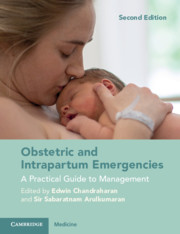Book contents
- Obstetric and Intrapartum Emergencies
- Obstetric and Intrapartum Emergencies
- Copyright page
- Contents
- Contributors
- Preface
- Preface to the First Edition
- Acknowledgements
- Section 1 General Principles
- Chapter 1 Anatomical and Physiological Changes in Pregnancy
- Chapter 2 Principles of Resuscitation for ‘Maternal Collapse’ During Pregnancy, Labour and Postpartum
- Section 2 Algorithms for Management of the Top Five ‘Direct Killers’
- Section 3 Intrapartum Emergencies
- Section 4 Postpartum Emergencies
- Section 5 Medical and Surgical Emergencies During Pregnancy
- Section 6 Anaesthetic Emergencies During Pregnancy
- Section 7 Neonatal Emergencies and the Management of Immediate Neonatal Problems
- Section 8 Management of Anticipated and Non-anticipated Emergencies in Pregnancy
- Section 9 Setting-Up Skills and Drills Training in Maternity Services and Reducing Avoidable Harm
- Index
- References
Chapter 2 - Principles of Resuscitation for ‘Maternal Collapse’ During Pregnancy, Labour and Postpartum
Airway, Breathing and Circulation
from Section 1 - General Principles
Published online by Cambridge University Press: 06 May 2021
- Obstetric and Intrapartum Emergencies
- Obstetric and Intrapartum Emergencies
- Copyright page
- Contents
- Contributors
- Preface
- Preface to the First Edition
- Acknowledgements
- Section 1 General Principles
- Chapter 1 Anatomical and Physiological Changes in Pregnancy
- Chapter 2 Principles of Resuscitation for ‘Maternal Collapse’ During Pregnancy, Labour and Postpartum
- Section 2 Algorithms for Management of the Top Five ‘Direct Killers’
- Section 3 Intrapartum Emergencies
- Section 4 Postpartum Emergencies
- Section 5 Medical and Surgical Emergencies During Pregnancy
- Section 6 Anaesthetic Emergencies During Pregnancy
- Section 7 Neonatal Emergencies and the Management of Immediate Neonatal Problems
- Section 8 Management of Anticipated and Non-anticipated Emergencies in Pregnancy
- Section 9 Setting-Up Skills and Drills Training in Maternity Services and Reducing Avoidable Harm
- Index
- References
Summary
The incidence of maternal collapse and severe maternal morbidity is unknown. Recent studies estimate that maternal collapse occurs in between 0.14 and 6 per 1000 births [1, 2]. In hospital, maternal collapse and sudden cardiac arrest are usually related to peripartum events and the outcome depends on effective resuscitation and identification and effective treatment of the underlying cause [3]. Therefore, staff on the delivery suite must be expertly trained in advanced life-support techniques and resuscitation equipment should be readily available.
- Type
- Chapter
- Information
- Obstetric and Intrapartum EmergenciesA Practical Guide to Management, pp. 10 - 16Publisher: Cambridge University PressPrint publication year: 2021



